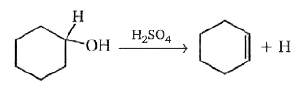Balz-Schiemann reaction.
Step-by-Step Solution for Balz-Schiemann Reaction
1. Starting Material: The reaction begins with aniline (C6H5NH2). Aniline is an aromatic amine that will undergo diazotization.
2. Diazotization: Aniline is treated with nitrous acid (HNO2), which is usually generated in situ from sodium nitrite (NaNO2) and a mineral acid (like HCl). The reaction converts the amino group (-NH2) of aniline into a diazonium salt (C6H5N2+). The reaction can be represented as:
C6H5NH2+HNO2→C6H5N2++2H2O
3. Formation of Fluorobenzene: The diazonium salt (C6H5N2+) is then treated with tetrafluoroborate (HBF4). The tetrafluoroborate ion (BF4-) acts as a fluoride source. The reaction can be represented as:
C6H5N2++HBF4→C6H5F+N2+BF3
Here, the diazonium ion loses nitrogen gas (N2) and forms fluorobenzene (C6H5F) as the final product.
4. Heating: The reaction mixture is heated to facilitate the release of nitrogen gas and the formation of the final product, fluorobenzene.
5. Final Products: The final products of the Balz-Schiemann reaction are fluorobenzene (C6H5F), nitrogen gas (N2), and boron trifluoride (BF3).
Summary of the Reaction:
- Reactants: Aniline, HNO2, HBF4
- Intermediate: Diazonium salt (C6H5N2+)
- Final Product: Fluorobenzene (C6H5F) along with N2 and BF3
C6H5NH2+HNO2→C6H5N2++2H2O
C6H5N2++HBF4→C6H5F+N2+BF3
Here, the diazonium ion loses nitrogen gas (N2) and forms fluorobenzene (C6H5F) as the final product.
- Reactants: Aniline, HNO2, HBF4
- Intermediate: Diazonium salt (C6H5N2+)
- Final Product: Fluorobenzene (C6H5F) along with N2 and BF3
Topper's Solved these Questions
Similar Questions
Knowledge Check
- Question 1 - Select One
Which of the following reaction is an elimination reaction ?
A B
B C
C Dboth (a) and (b)
Dboth (a) and (b) - Question 2 - Select One
Which of the following reaction is calld 'Schotten-Baumann' reaction ?
AC6H6AlCl3/CH3COCl−−−−−−−−−−→C6H5COCH3BC6H5NH2CH3COCl−−−−−→C6H5NHCOCH3CC6H5OHC6H5COCl−−−−−−→C6H5OCOC6H5DC6H6AlCl3−−−−−−→C6H5COClC6H5COC6H5
What is Combination reaction ? Explain with the help of chemical reaction .
View SolutionWhich of the followig reaction is not a ion-exchange reaction?
View SolutionThe rate constant of a reaction has same units as the rate of reaction. The reaction is of:
View SolutionDifferenctiate between,- a. Direct combination reaction & a decomposition reaction b. Displacement reaction & a neutralization reaction.
View SolutionDefine the term 'order of reaction' for chemical reactions.
View SolutionIn the replacement reaction The reaction will be most favourable if M happens to be -
View Solution

